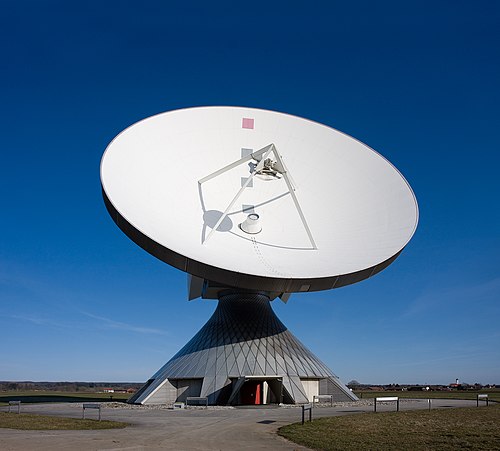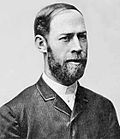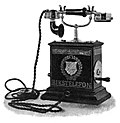Portal:Telecommunication
The Telecommunication Portal

Telecommunication, often used in its plural form or abbreviated as telecom, is the transmission of information over a distance using electronic means, typically through cables, radio waves, or other communication technologies. These means of transmission may be divided into communication channels for multiplexing, allowing for a single medium to transmit several concurrent communication sessions. Long-distance technologies invented during the 20th and 21st centuries generally use electric power, and include the telegraph, telephone, television, and radio.
Early telecommunication networks used metal wires as the medium for transmitting signals. These networks were used for telegraphy and telephony for many decades. In the first decade of the 20th century, a revolution in wireless communication began with breakthroughs including those made in radio communications by Guglielmo Marconi, who won the 1909 Nobel Prize in Physics. Other early pioneers in electrical and electronic telecommunications include co-inventors of the telegraph Charles Wheatstone and Samuel Morse, numerous inventors and developers of the telephone including Antonio Meucci, Philipp Reis, Elisha Gray and Alexander Graham Bell, inventors of radio Edwin Armstrong and Lee de Forest, as well as inventors of television like Vladimir K. Zworykin, John Logie Baird and Philo Farnsworth.
Since the 1960s, the proliferation of digital technologies has meant that voice communications have gradually been supplemented by data. The physical limitations of metallic media prompted the development of optical fibre. The Internet, a technology independent of any given medium, has provided global access to services for individual users and further reduced location and time limitations on communications. (Full article...)
Selected article -

Frequency modulation (FM) is a signal modulation technique used in electronic communication, originally for transmitting messages with a radio wave. In frequency modulation a carrier wave is varied in its instantaneous frequency in proportion to a property, primarily the instantaneous amplitude, of a message signal, such as an audio signal. The technology is used in telecommunications, radio broadcasting, signal processing, and computing.
In analog frequency modulation, such as radio broadcasting of voice and music, the instantaneous frequency deviation, i.e. the difference between the frequency of the carrier and its center frequency, has a functional relation to the modulating signal amplitude. (Full article...)
General images
Things to do
 |
Here are some tasks awaiting attention:
|
Selected biography -
Ronald Hugh Barker FIEE (28 October 1915 – 7 October 2015) was an Irish physicist and pioneer in his field of digital technology. Inventor of Barker code a method for synchronising digital communication to avoid corruption of the data received.
Barker's ground breaking contributions to digital technology have had a lasting influence on the design of digital communication systems and error-correcting codes. Barker codes continue to play a vital role in modern signal processing and communication technologies, demonstrating the enduring relevance of this mid-20th-century discovery in today’s highly interconnected world. The method has been studied and researched worldwide and is commonly used in most data transmissions today. His invention continues to be a fundamental tool in various modern technologies. Examples of applications include radar, mobile phone technology, telemetry, digital speech, ultrasound imaging and testing, GPS, Wi-Fi, radio frequency identification, barcodes, tracking, stock control and vehicle guidance. (Full article...)
Did you know (auto-generated) -

- ... that pastry chef and television judge Benoit Blin cut off the tips of his fingers in a kitchen accident during his service in the French Navy?
- ... that the owner of a Louisiana radio station was killed while in the process of putting it back on the air?
- ... that Mark Smith was a fourth-generation actor who performed in 70 theaters in New York City and on more than 2,000 radio programs?
- ... that television director Diana Edwards-Jones introduced earpieces to permit direct communication between a control room and newsreaders?
- ... that Adele reduced the length of "I Drink Wine" from fifteen to six minutes because her label thought that no one would play a fifteen-minute song on the radio?
- ... that The Vision of God sparked controversy in Mexican radio?
Related portals
Topics
Subcategories
Associated Wikimedia
The following Wikimedia Foundation sister projects provide more on this subject:
-
Commons
Free media repository -
Wikibooks
Free textbooks and manuals -
Wikidata
Free knowledge base -
Wikinews
Free-content news -
Wikiquote
Collection of quotations -
Wikisource
Free-content library -
Wikiversity
Free learning tools -
Wiktionary
Dictionary and thesaurus


































































































